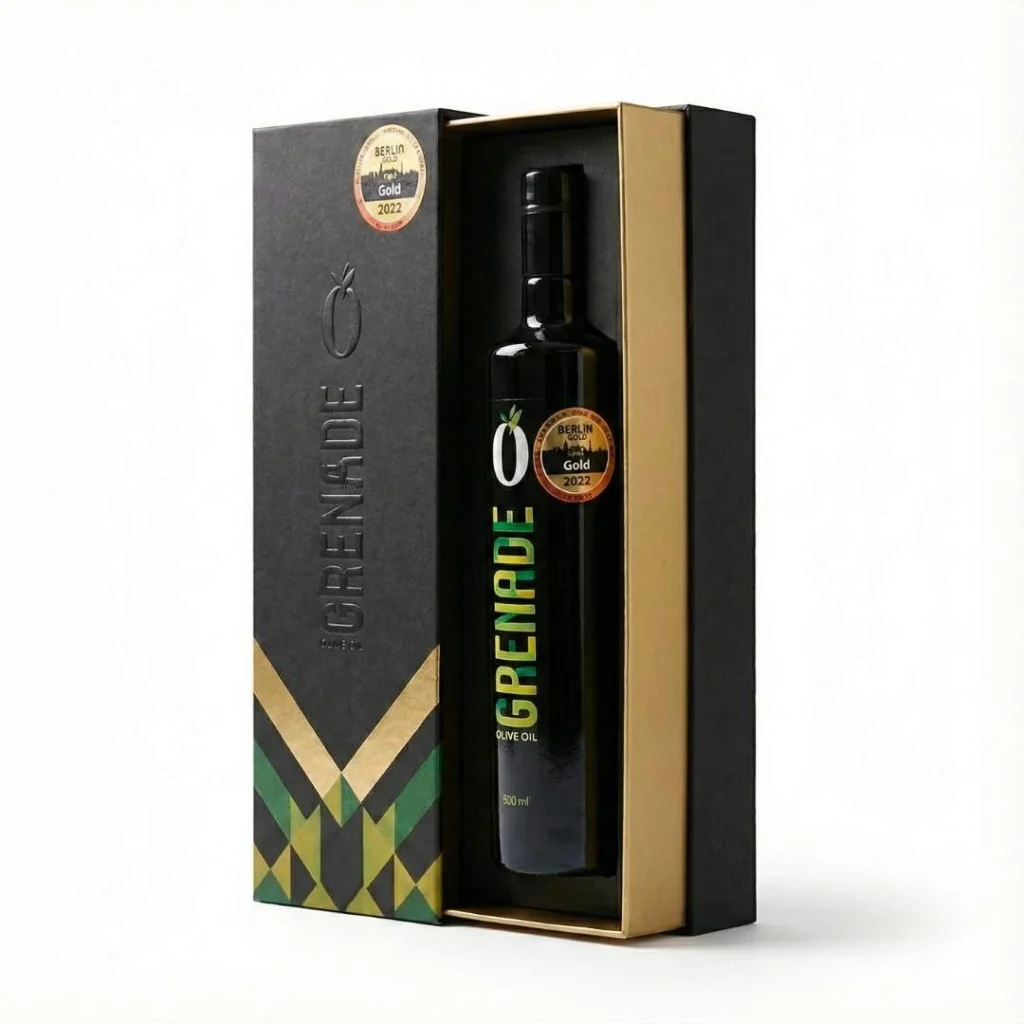
Gourmet extra virgin olive oil (EVOO) is a culinary treasure, but when faced with its shades-vibrant green or warm gold-the question arises: which one to choose?
These colors are not just an aesthetic whim; they reveal stories of taste, harvest, variety and use. On this journey, we will unravel the differences between green and golden gourmet oil, exploring their origin, taste profile, cooking applications and more.
If you are looking for the perfect companion for your dishes, read on and discover which shade of this liquid gold will conquer your palate and elevate your creations.
What does green or gold mean?
The hue of a gourmet extra virgin olive oil is no coincidence: it is a visual clue to its process and essence. Green EVOO, with intense emerald hues, usually comes from olives harvested early, when they are still green and not fully ripe.
This method, common in varieties such as picual or frantoio, preserves chlorophylls, giving that vivid color.
On the other hand, the golden EVOO, with warm yellow reflections, is made with riper olives, harvested late, where chlorophyll is transformed into golden pigments. The difference goes beyond the eye: the time of harvesting shapes the flavor, texture and aroma, making each shade a unique experience.
Flavor profile: Intensity vs. smoothness
The personality of the gourmet oil is reflected in its flavor, and the color is a clear indication. Green EVOO tends to be robust and bold. Expect herbaceous notes, such as freshly cut grass, artichoke or green tomato, with a bitter touch and a spicy finish in the throat, thanks to the abundant polyphenols in young olives.
It is a vibrant profile, full of character. In contrast, golden EVOO is softer and more delicate. With ripe olives, it offers sweet and fruity flavors-think almond, ripe apple or banana-with a silky texture and less intensity.
Trying both is like comparing a wild walk in the countryside with a peaceful sunset: each shines in its own way.
Production Process: Harvesting and milling
The magic begins in the olive grove. For green oil, growers harvest olives at an early stage, often by hand, between October and November. This process is laborious: green olives are firmer and yield less oil, but their quality is exceptional. They are cold pressed quickly, at less than 27 °C, to capture freshness and antioxidants.
Golden EVOO, on the other hand, comes from ripe olives, harvested later, in December or January. These fruits, softer and juicier, produce a greater quantity of oil, with a focus on smoothness. Both undergo cold extraction, but the time of harvest defines their character: the green is fresh and intense; the golden, rich and round.
Nutritional content
Gourmet extra virgin olive oil is an ally of health, but its tones reveal nuances.
Green EVOO, rich in polyphenols and antioxidants due to early harvesting, fights inflammation and strongly protects the heart. Its high content of chlorophyll and bioactive compounds makes it ideal for those looking for a healthy boost.
The golden EVOO, although with fewer polyphenols, still offers beneficial monounsaturated fats and vitamin E, with a more balanced profile. Both are stars of the Mediterranean diet, but the green one stands out for its antioxidant power, while the golden one brings softness and versatility. Whichever you choose, your body will be grateful for every spoonful.
The brightness of oil in the kitchen
The choice between green and golden transforms your dishes. Green EVOO, with its intensity, is perfect for raw uses. Drizzle it over arugula salads, meat or fish carpaccios, or a fresh gazpacho, where its spiciness and herbaceous notes awaken the flavors. Use it to finish dishes, as a touch on hummus or a tomato soup, letting its character speak.
The softer golden EVOO shines in delicate preparations: emulsify a homemade mayonnaise, bake a moist lemon sponge cake or dress steamed vegetables to bring out their natural sweetness. Although both withstand gentle cooking, it saves its purity for raw: green brings boldness; golden, subtle elegance.

Organic Oil – Premium EVOO 750 ml
Gourmet olive oil. Pure Spanish green oil awarded for its quality.
19,90€
Pairings to surprise
Gourmet EVOO elevates any pairing. Green oil, with its vigor, pairs wonderfully with strong cheeses such as cured Manchego or Cabrales, cutting through the richness with its freshness. Pair it with a dry white wine, such as a verdejo, for a refreshing contrast.
Golden EVOO, with its softness, embraces delicate flavors: try spreading it on bread with fig jam, or drizzle it over smoked salmon. A light red wine, such as a pinot noir, or a mild cider enhances its sweetness. For desserts, gold shines in vanilla ice cream, while green adds a bold twist to dark chocolates. Experiment and find your perfect pairing.
The color of gourmet EVOO not only influences the taste, but also the visual experience. A green oil, with its emerald hue, looks spectacular in a clear glass bottle on the table, inviting you to dip bread or dress on the spot.
Its liveliness arouses curiosity and promises intensity. The golden EVOO, with warm reflections, evokes luxury and warmth, perfect for presenting in an elegant decanter with a sophisticated dinner. When serving, use small ceramic tasting bowls, letting diners admire the hue before savoring. Color doesn’t just garnish: it tells the story of the oil before the first bite.
How to Choose: Green or gold?
The decision depends on your taste and purpose. If you love intense, fresh flavors and a rustic touch, green EVOO is your ally. Look for varieties such as picual or cornicabra, ideal for raw and bold dishes. If you prefer softness, sweetness and versatility, golden EVOO, such as arbequina, will win you over, especially in desserts or delicate recipes.
Consider the occasion: green impresses with characterful appetizers; gold elevates elegant dinners.
Find out more about our quality oils in our online store.











